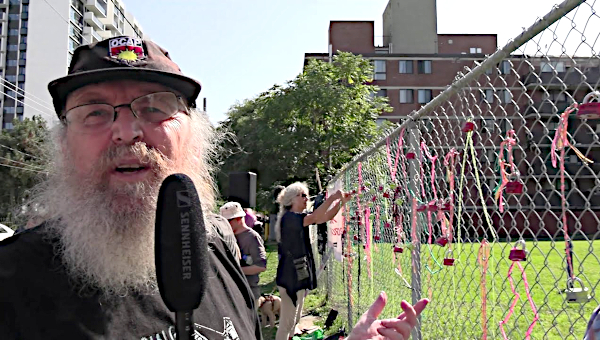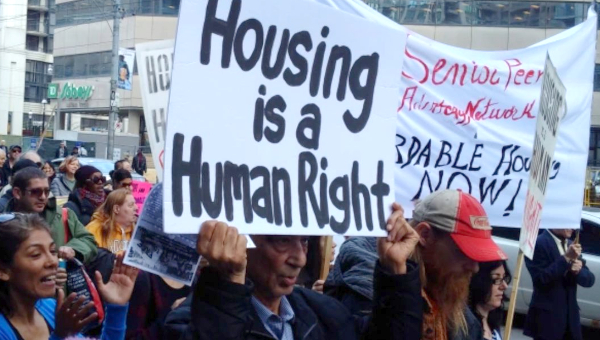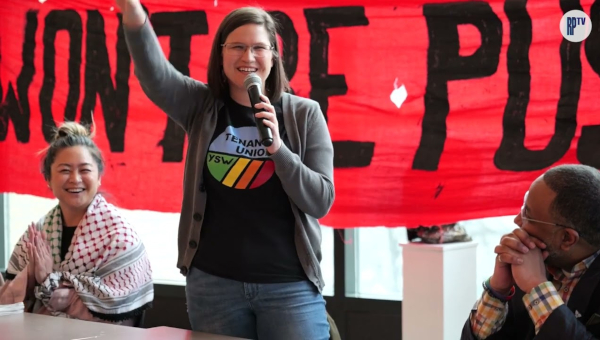The Fight Against Street Deaths in Toronto
The twin agendas of urban redevelopment and austerity have increased the scale of the homeless crisis in Toronto. Over 4,000 people cram into the emergency shelters every night and many more try to survive out on the streets. This situation raises the question of what lengths the agenda of austerity can be taken to. If people are allowed to freeze to death for lack of basic shelter then we have moved beyond reduced entitlement and arrived at a situation of reckless and lethal social abandonment.

As the New Year got underway, four homeless men perished in Toronto within a less than two week period. Two froze to death, one burned lighting a fire to try and stay warm and a fourth man came in from the cold, under the City’s ‘respite program’ and died inside the Peter Street referral centre. All of these deaths took place against a backdrop of worsening conditions and acute overcrowding within the City’s homeless shelter system.The problem of crowded shelters goes back a long way. When the Mike Harris Tories came to power in Ontario, in 1995 and massively cut social assistance rates, the demand for shelters in Toronto exploded. A series of appalling street deaths forced the City to open more space and adopt a policy of keeping shelter occupancy levels at 90 per cent. Over the years that followed, however, the City Administration simply disregarded that policy and allowed the overcrowding problem to get worse. By 2012, street deaths were again spiking and the conditions in the shelters becoming intolerable. The Mayor at this time was Rob Ford and he publicly took the position that occupancy levels of 96 per cent were perfectly acceptable.
Overcrowded Shelters
It’s necessary to provide some explanation on the issue of shelter occupancy. Senior City administrators have made a long standing practice of trying to understate the overcrowding problem and they do this in various ways. They present an across the system average occupancy level that means little to many people trying to get a bed. If the women’s shelters are full, a few empty beds in the men’s system are of no help to women forced onto the streets. If family motels have an occupancy rate of only 70 per cent this can be used to create an average figure that understates the crowding in shelters in the central part of the City. The bed count within the system is completed at 4:00 a.m. and this works to conceal the true picture. Earlier in the evening, homeless people, front line workers and advocates have been trying to find bed space, often unsuccessfully. The numbers who are turned away or who despair of finding a bed don’t show up in the figures. This aside, however, a homeless shelter that is at or close to 100 per cent full is very hard to endure. Overcrowding creates tension and violence and forces people out onto the streets, either because they can’t take the conditions or because those in charge respond to incidents caused by the overcrowding with disciplinary measures and exclude people. The 90 per cent figure was not pulled out of the air but was selected as the maximum level for tolerable and accessible shelter facilities.
So, in 2012, OCAP and others in the community began to step up the challenge around Toronto’s overflowing shelter system. Protests were held, angry delegations were taken to shelter administration offices and two large scale occupations were organized. In February, 2013, we brought out dozens of people and set up our own ‘homeless shelter’ inside City Hall right in front of the Mayor’s office. When police moved in and made some forty arrests at day’s end, we responded by repeating the action at Metro Hall. Again, large numbers of arrests ensued but the momentum and community support we had generated with these actions created a breakthrough. At the April meeting of City Council, with Mayor Ford casting the only dissenting vote, the 90 per cent occupancy policy was reaffirmed.
Now began a relentless effort by senior bureaucrats to ensure that as little as possible was done to comply with the Council decision. So-called ‘flex beds,’ up until then used only during extreme cold alerts, were now thrown on the floor of common areas every night. The response to overcrowding was to increase the overcrowding. The situation was particularly dreadful within the women’s shelters. In September, a homeless woman sleeping out in the downtown east was sexually assaulted by two men at different times during the night. Women members in OCAP played the major role in ensuring downtown east women organized to demand safe space. This included a women’s delegation to City Hall in October.
By the beginning of 2014, some hard won practical concessions were obtained. A temporary women’s shelter was opened and Metro Hall was used as a warming centre for homeless people during cold weather alerts, of which there were many that winter. A pledge was made to open 24-hour drop in space for homeless women and trans people by year’s end. However, the bureaucracy again worked to undermine these gains. A report to Council that would have enabled the two drop ins to open on time, was delayed and shelter occupancy continued to run at levels in violation of stated policy.
As cold weather began to set in, we were seriously alarmed at the impending threat to life and well being for those on the streets. On October 25, the UN Day for the Elimination of Violence Against Women, a march to City Shelter Administration offices was held and a five women strong delegation entered the place to demand negotiations on the crisis within the shelters and the lack of promised safe space. The bureaucrats were obdurate and refused to have any dealings with the delegation. Police were brought in and arrested the five with what can only be described as misogynistic abuse and violence. Charges of mischief to property and forcible entry were laid and remain in effect as of this time. Legal support and solidarity with the October 25 arrestees is being organized.
Spate of Street Deaths
The disgraceful treatment of the OCAP women’s delegation did not succeed in intimidating us or undermine the drive to win real improvements for the homeless. As we prepared to take further action in the New Year, tragic events brought things to a head. The spate of street deaths in January of this year sparked community outrage. On January 15, immediately after the second death, OCAP took a delegation directly to the Mayor’s office. A group of us were able to get right into the reception area, while other supporters converged outside the hastily locked doors. It proved to be a well timed action because the Mayor and his advisors were actually meeting to discuss the crisis on the streets. We were demanding the opening of warming centres even though the temperature was slightly above the -15c that is supposed to trigger an extreme cold weather alert. Newly elected mayor John Tory decided not to wait for such a call from the Board of Health but to instruct shelter management to open the extra facilities anyway.
At the next meeting of the Community Development and Recreation Committee of City Council, staff reported that they would be opening emergency beds in city motels and a number of measures were now included in the 2015 Budget proposals. Nearly all of a $7.9-million ‘poverty reduction’ expenditure will be devoted to opening 181 new shelter beds, including 54 for LGBTQ youth, and establishing two 24-hour drop in spaces for homeless women and trans people. Enhanced services will also be provided through drop ins during ‘severe weather events.’ These are real gains that will increase the chance homeless people have of surviving and they will provide some measure of dignity for people seeking shelter from the elements.
Struggle for Housing
There are several key considerations that flow from the homeless crisis and the determined challenge that has been taken up over the last couple of years. First of all, the concessions that have been won are the direct result of community action that has successfully challenged an administration that would have otherwise permitted homeless people to die on the streets. Secondly, however, these gains are fragile in that we are dealing with a regime that has a long history of providing as little as possible only when absolutely necessary and taking back what it gives when it feels able to.
Most important of all, it’s necessary to place this limited victory in context. John Tory has been brought in to front an operation concerned with consolidating Toronto’s place as a ‘neoliberal city.’ Unlike his crude and dysfunctional predecessor, he has the sophistication to realise that street deaths in the homeless population, if they are challenged in a loud and clear fashion, are unhelpful to the illusion of consensus he is working to create. In the year when the Pan Am Games will be hosted in Toronto, and the right image needs to be struck, a few million to ensure that homeless people are at least sheltered is money well spent. It was a well considered tactical concession on the part of his regime.
As $7.9-million are grudgingly allocated to ‘poverty reduction’ the City also budgets $3.8-million just to light up the Bloor Street Viaduct during this Summer’s Games. Meanwhile, close to 170,000 people sit on the waiting list for housing in this City as the municipality greases the wheels of a reckless condo boom. We’ve taken up a necessary fight to prevent people being abandoned to death on the streets and we can draw strength from the gains that have been made. At the same time, however, the very fact that we must fight for shelter beds, rather than winning the housing that should replace them, is a sign of how weak our movement is. The struggle for housing needs to become a key element of a working-class movement against austerity that defends its gains, fights to win back that which has been taken away and leaves no one behind in the process. •





